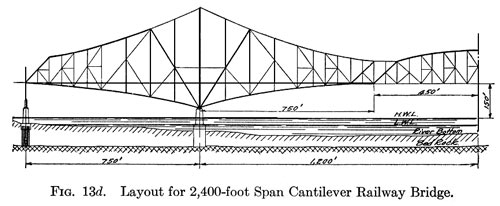| ECONOMICS OF CANTILEVER AND SUSPENSION BRIDGES | 97 |
|
In order, however, to make the comparison perfectly fair, the anchor-piers of the cantilever bridge were also figured as resting on piles driven to bed rock. The result of this change was a large reduction of the difference in cost between the two types of structure compared, as shown by the following totals: $4,080,000 and $6,387,000. These are the costs which are plotted in Fig. 13c. After noting the large difference in these total costs, the author decided to test a twenty-four-hundred-foot opening, thinking that surely for such a long span the suspension bridge would be the cheaper. The bed rock was kept at the same elevation as before. the only difference in the profile being that the width of river was increased, as shown in Fig. 13d and Fig. 13e. It was decided, in order to save labor, to do no further computing upon the basis of main piers resting on piles; but all anchor piers and anchorages were assumed to be thus supported, as in the final estimates for the 1,700-foot
spans. Much to the author's surprise, the results showed the cantilever structure to be still the cheaper, the total costs being $10,210,000 and $12,033,000. Then an opening of twenty-seven hundred feet was tested, the result being $15,269,000 for the cantilever bridge and $15,259,000 for the suspension bridge. This shows that for double-track-railway bridges of nickel steel, the span-length for equal costs of cantilever and suspension bridges is 2,700 feet, or one hundred feet longer than the greatest advisable length for the former type recommended by the author in his paper on "The Possibilities in Bridge Construction by the Use of High-Alloy Steels." In order properly to plot the curves in Fig. 13c, it was necessary to compute the cost of a cantilever bridge having a span of 2,050 feet. This gave four points on the curve and enabled it to be sketched in satisfactorily, after which it was easy to draw the corresponding curve for the suspension bridge. In order to make as good a showing as practicable for the suspension bridge, as far as the layout is concerned; it was decided to assume that the bed rock comes quickly to the surface in the vicinity of the main piers and runs back thereafter at an elevation of about ten feet above high water in the manner adopted by Dr. Steinman. This assumption reduces greatly |
